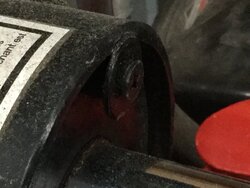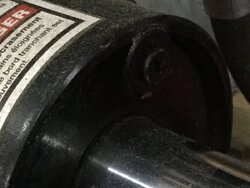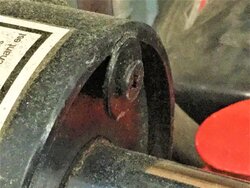I have an answer though in case you're curious.
That screw and washer does in fact need to be there. It is to prevent the end cap of the cylinder from being sucked into the cylinder when the wedge is retracted.
The screw and washer are used as a safety device to prevent the end cover from being pushed in exposing the lock ring holding the cylinder together. The missing screw and washer would not cause the cylinder to fail.
I'd be interested in some sort of schematic for these cylinders.
Seeing as though I have one of these now, I was curious how it's put together. In searching for an answer, it ended up the terms to look for were "hydraulic cylinder gland" and "retaining ring". And a whole world of hydraulic cylinders seals and methods of assembly opened up. What it all boiled down to were really four methods of retaining the "gland" or plug at the end of the cylinder -
1) tie rod assembly, where rods extend the length of the cylinder holding both ends tight
2) gland internally threaded, and using a spanner wrench to un screw the gland from the end
3) gland held by an internal retaining ring well in from the end, with the ring accessed either on the outside of the cylinder, or in one case through the low side port
4) gland held by an internal snap ring out at the end, accessed by pushing the gland inward enough to get a snap wring pliers on it, or, on some the snap rings are actually flat spirals that unravel and are pulled out with a pick. It appears we have the last variety, gland pushed in to access the internal snap ring out at the end, with the ring barely out of sight.
As far as the small bracket/washer and screws on the end, what I'm guessing is that for the application, splitting cordwood, all kinds of stuff can get lodged in and around that cylinder end, and push the gland end in before anyone realizes. Normally on things like scissor lifts and bucket loaders there is no debris pile up issue, so no reason to retain the gland "out" where it belongs. System pressure alone would keep it there.
Cheep lightweight built for a splitter.
Yah, that kind of works in our favor. If the opposite were true, I wouldn't like that as much. This type of assembly is used all over, not just splitters.
There are bajillions of huskee 22 splitters out there
I'll go with that. I'm still confident I did the right thing by choosing one, and expect to get a long useful life out of it.




